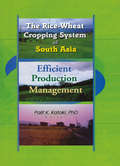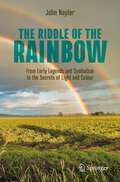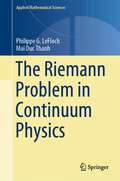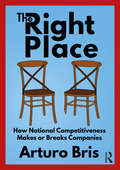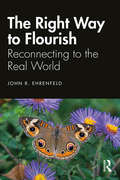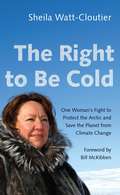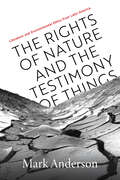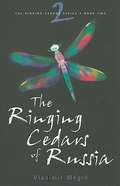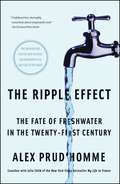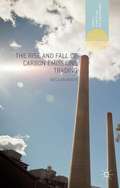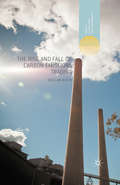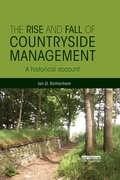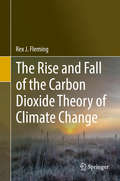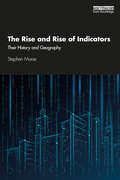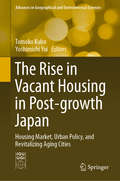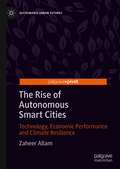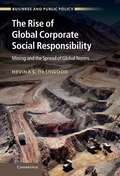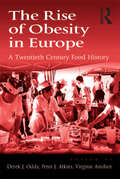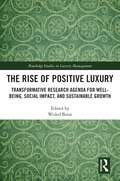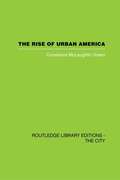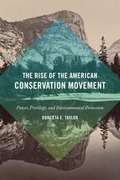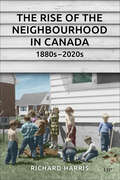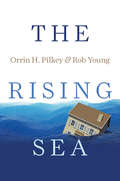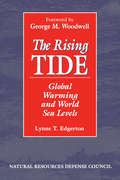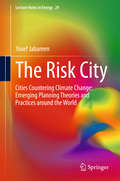- Table View
- List View
The Rice-Wheat Cropping System of South Asia: Efficient Production Management
by Suresh Chandra Babu Palit KatakiThe lives of more than a billion people depend on the answer!This valuable book surveys the problems of the rice-wheat cropping system practiced on the Indo-Gangetic Plain (IGP). Introduced at the time of the Green Revolution, it transformed agriculture and produced thirty years of bumper crops. The Rice-Wheat Cropping System of South Asia: Efficient Production Management offers scientific analysis of the aftereffects of this intense cropping. The Rice-Wheat Cropping System of South Asia: Efficient Production Management focuses on the questions of soil depletion, pest infestation, and soil alkalinity as elements of declining productivity. Along with clear charts, maps, and graphs, it provides practical suggestions for improving and maintaining the productivity of this irreplaceable farmland. The Rice-Wheat Cropping System of South Asia looks at the problems that have arisen for both the rice and wheat phases, including: depletion of micronutrients degradation of major nutrients from unbalanced fertilization practices infestations of nematodes increasing soil alkalinity as a result of irrigationIt also suggests solutions for maintaining productivity, including: integrated pest management sustainable agriculture micronutrient fertilizersThis informative book and its companion volume, The Rice-Wheat Cropping System of South Asia: Trends, Constraints, Productivity and Policy, are essential planning tools for agronomists, policymakers, and agroeconomists. It is also a useful reference for anyone interested in the problems of famine and intensive cropping not only in South Asia but in the world.
The Riddle of the Rainbow: From Early Legends and Symbolism to the Secrets of Light and Colour (Copernicus Books)
by John NaylorRainbows have been a source of fascination since time immemorial. They have been the subject of myth and superstition, an inspiration to poets, a challenge to painters, the object of intense scientific interest and a touchstone for ideas about the nature of light and colour. Above all, the rainbow has been the embodiment of wonder from the earliest times to the present day.Beginning with the circumstances in which you are likely to see a rainbow and descriptions of its salient features, this book recounts and explains the myths and superstitions about rainbows, and describes how poets, painters and, above all, leading scientists in every age have sought to discover and understand the rainbow’s secrets.Readers with a love of nature and art and an interest in the history of science will enjoy this attractive and informative book.
The Riemann Problem in Continuum Physics (Applied Mathematical Sciences #219)
by Philippe G. LeFloch Mai Duc ThanhThis monograph provides a comprehensive study of the Riemann problem for systems of conservation laws arising in continuum physics. It presents the state-of-the-art on the dynamics of compressible fluids and mixtures that undergo phase changes, while remaining accessible to applied mathematicians and engineers interested in shock waves, phase boundary propagation, and nozzle flows. A large selection of nonlinear hyperbolic systems is treated here, including the Saint-Venant, van der Waals, and Baer-Nunziato models. A central theme is the role of the kinetic relation for the selection of under-compressible interfaces in complex fluid flows. This book is recommended to graduate students and researchers who seek new mathematical perspectives on shock waves and phase dynamics.
The Right Place: How National Competitiveness Makes or Breaks Companies
by Arturo BrisThe Right Place explains why firms succeed in one country and fail in another, irrespective of their inner drivers, and suggests potential initiatives that governments can take to help the private sector create jobs and, consequently, make their countries more prosperous. The competitiveness race is not unlike a cycling race. If you want to ride fast, you need three things: a good bike, to be in good shape, and a smooth and fast road. In a collaborative model, you might say the business is the bicycle, the business leader is the cyclist, and the road is the government and the external environment. The responsibility of a government is to design and build the best possible road. It turns out that when the road is good, good cyclists suddenly appear and want to race on it. In this book, competition and macroeconomics expert, Arturo Bris, provides the analysis of country competitive performance based on 30 years advising countries on this topic. The typical mistakes that countries make are revealed and the pillars necessary in building a competitive economy: economic performance as a necessary condition for prosperity; government efficiency, so the public sector can create the conditions for a productive economy; business efficiency, so companies can create jobs; and infrastructure, both tangible and intangible, so businesses and individuals can operate efficiently. With contemporary case studies throughout, the book provides an illuminating read for politicians, business leaders and students of macroeconomics.
The Right Way to Flourish: Reconnecting to the Real World
by John EhrenfeldIn this ground-breaking book, pre-eminent thought leader in the fields of sustainability and flourishing, John R. Ehrenfeld, critiques the concept of sustainability as it is understood today and which is coming more and more under attack as unclear and ineffective as a call for action. Building upon the recent work of cognitive scientist, Iain McGilchrist, who argues that the human brain’s two hemispheres present distinct different worlds, this book articulates how society must replace the current foundational left-brain-based beliefs – a mechanistic world and a human driven by self interest – with new ones based on complexity and care. Flourishing should replace the lifeless metrics now being used to guide business and government, as well as individuals. Until we accept that our modern belief structure is, itself, the barrier, we will continue to be mired in an endless succession of unsolved problems.
The Right to Be Cold: One Woman's Fight to Protect the Arctic and Save the Planet from Climate Change
by Sheila Watt-CloutierA &“courageous and revelatory memoir&” (Naomi Klein) chronicling the life of the leading Indigenous climate change, cultural, and human rights advocate For the first ten years of her life, Sheila Watt-Cloutier traveled only by dog team. Today there are more snow machines than dogs in her native Nunavik, a region that is part of the homeland of the Inuit in Canada. In Inuktitut, the language of Inuit, the elders say that the weather is Uggianaqtuq—behaving in strange and unexpected ways. The Right to Be Cold is Watt-Cloutier&’s memoir of growing up in the Arctic reaches of Quebec during these unsettling times. It is the story of an Inuk woman finding her place in the world, only to find her native land giving way to the inexorable warming of the planet. She decides to take a stand against its destruction.The Right to Be Cold is the human story of life on the front lines of climate change, told by a woman who rose from humble beginnings to become one of the most influential Indigenous environmental, cultural, and human rights advocates in the world. Raised by a single mother and grandmother in the small community of Kuujjuaq, Quebec, Watt-Cloutier describes life in the traditional ice-based hunting culture of an Inuit community and reveals how Indigenous life, human rights, and the threat of climate change are inextricably linked. Colonialism intervened in this world and in her life in often violent ways, and she traces her path from Nunavik to Nova Scotia (where she was sent at the age of ten to live with a family that was not her own); to a residential school in Churchill, Manitoba; and back to her hometown to work as an interpreter and student counselor. The Right to Be Cold is at once the intimate coming-of-age story of a remarkable woman, a deeply informed look at the life and culture of an Indigenous community reeling from a colonial history and now threatened by climate change, and a stirring account of an activist&’s powerful efforts to safeguard Inuit culture, the Arctic, and the planet.
The Rights of Nature and the Testimony of Things: Literature and Environmental Ethics from Latin America
by Mark AndersonThe Rights of Nature and the Testimony of Things begins by analyzing the ethical debates and political contexts relating to Latin American &“rights of nature&” legislation and the political ontology of nonhuman speech within a framework of intercultural and multispecies diplomacy. Author Mark Anderson shows how Latin American authors and thinkers complicate traditional humanistic perspectives on nature, the social, and politics, exploring how animals, plants, and environments as a whole might be said to engage in social relations and political speech or self-representation. Drawing Native Amazonian thought into productive tension with a variety of posthumanist theoretical frameworks—ranging from Derrida&’s conceptualization of passive decision and hospitality to biosemiotics, Karen Barad&’s theorization of intra-activity, and Isabelle Stengers&’ proposal for cosmopolitical diplomacy—Anderson analyzes literary works by Julio Cortázar, Clarice Lispector, José Eustasio Rivera, and Davi Kopenawa that reframe environmental ethics in terms of collective, multispecies work and reciprocal care and politics as a cosmopolitics of friendship rooted in diplomacy across difference. Finally, Anderson examines the points of connection and divergences between Latin American relational ontologies and Euro American posthumanist theories within Indigenous Latin American remodernization projects that reappropriate and repurpose ancestral practices as well as develop new technologies with the goal of forging alternative modernities compatible with a livable future for all species.
The Ringing Cedars of Russia (The Ringing Cedars Series #2)
by Vladimir Megré John Woodsworth Leonid SharashkinAfter rising rapidly to the top of national best-seller lists, first-time author Vladimir Megre has some explaining to do.
The Ripple Effect
by Alex Prud'HommeNow in paperback from the bestselling coauthor with Julia Child of My Life in France "a balanced and insightful assessment of what could emerge as the dominant issue in decades ahead" (Associated Press)--the fate of fresh water in the twenty-first century.With The Ripple Effect, Alex Prud'homme has changed the way we think about the water we drink. Inspired by an interest in our worldwide obsession with bottled water, Prud'homme undertook an ambitious quest to understand the evolving story of freshwater. What he found was shocking: as the climate warms and world population grows, demand for water has surged, but supplies of fresh water are static or dropping, and new threats to water quality appear every day. The questions he sought to answer were urgent: Will there be enough water to satisfy demand? What are the threats to its quality? What is the state of our water infrastructure--both the pipes that bring us fresh water and the levees that keep it out? How secure is our water supply from natural disasters and terrorist attacks? Can we create new sources for our water supply through scientific innovation? Is water a right like air or a commodity like oil--and who should control the tap? Like Daniel Yergin's seminal classic The Prize: The Epic Quest for Oil, Money, & Power, The Ripple Effect is a masterwork of investigation and a dramatic narrative, spanning from the alleged murder of a water scientist in New Jersey to the epic confrontation between salmon fishermen and copper miners in Alaska. The Ripple Effect is a major achievement and will change our understanding of the importance of water forever. el Pollan has changed the way we think about the food we eat; Alex Prud'homme will change the way we think about the water we drink. Informative and provocative, The Ripple Effect is a major achievement.
The Rise and Fall of Carbon Emissions Trading (Energy, Climate and the Environment)
by Declan KuchThe Rise and Fall of Carbon Emissions Trading.
The Rise and Fall of Carbon Emissions Trading (Energy, Climate and the Environment)
by Declan KuchThis book presents the results of the first full-scale emissions trading schemes in Australia and internationally, arguing these schemes will not be sufficient to 'civilize markets' and prevent dangerous climate change. Instead, it articulates the ways climate policy needs to confront the collective nature of our predicament.
The Rise and Fall of Countryside Management: A Historical Account
by Ian D. RotherhamFor at least half a century since the emergence of Country Parks and Forest Parks, countryside services have provided leisure, tourism, conservation, restoration and regeneration across Britain. Yet these services are currently being decimated as public services are sacrificed to the new era of austerity. The role and importance of countryside management have been barely documented, and the consequences and ramifications of cuts to these services are overlooked and misunderstood. This volume rigorously examines the issues surrounding countryside management in Britain. The author brings together the results of stakeholder workshops and interviews, and in-depth individual case studies, as well as a major study for the Countryside Agency which assessed and evaluated every countryside service provision in England. A full and extensive literature review traces the ideas of countryside management back to their origins, and the author considers the wider relationships and ramifications with countryside and ranger provisions around the world, including North America and Europe. The book provides a critical overview of the history and importance of countryside management, detailing the achievements of a largely forgotten sector and highlighting its pivotal yet often underappreciated role in the wellbeing of people and communities. It serves as a challenge to students, planners, politicians, conservationists, environmentalists, and land managers, in a diversity of disciplines that work with or have interests in countryside, leisure and tourism, community issues, education, and nature conservation.
The Rise and Fall of the Carbon Dioxide Theory of Climate Change
by Rex J. FlemingThis book provides a complete review of the role of CO2 in the Earth’s atmosphere and reveals detailed information about the subject of climate change. Many different science disciplines are visited and discussed and each area is introduced with a brief summary written to appeal to a broader audience. The logic of CO2 involvement in changing the climate is investigated from every perspective: reviewing the historical data record of Ice Ages with vast ice sheets, noting the interglacial periods of little or no ice, examining in further detail the 20th century data record and evaluating the radiation role of CO2 in the atmosphere. The radiation calculations, using the appropriate equations and data are reviewed in great detail. The results of this review and examination reveal no role of CO2 in any change of the Earth’s climate. Disclaimer: The views expressed in this book belong solely to the author.
The Rise and Rise of Indicators: Their History and Geography
by Stephen MorseThis book makes indicators more accessible, in terms of what they are, who created them and how they are used. It examines the subjectivity and human frailty behind these quintessentially ‘hard’ and technical measures of the world. To achieve this goal, The Rise and Rise of Indicators presents the world in terms of a selected set of indicators. The emphasis is upon the origins of the indicators and the motivation behind their creation and evolution. The ideas and assumptions behind the indicators are made transparent to demonstrate how changes to them can dramatically alter the ranking of countries that emerge. They are, after all, human constructs and thus embody human biases. The book concludes by examining the future of indicators and the author sets out some possible trajectories, including the growing emphasis on indicators as important tools in the Sustainable Development Goals that have been set for the world up until 2030. This is a valuable resource for undergraduate and postgraduate students in the areas of economics, sociology, geography, environmental studies, development studies, area studies, business studies, politics and international relations.
The Rise in Vacant Housing in Post-growth Japan: Housing Market, Urban Policy, and Revitalizing Aging Cities (Advances in Geographical and Environmental Sciences)
by Tomoko Kubo Yoshimichi YuiThis book explores how Japanese cities have transformed since the 1950s by describing housing and urban planning policies, urbanization processes, and maps with GIS analysis. It also discusses how housing vacancies have increased in shrinking Japanese cities, with case studies in Tokyo, Kyoto, Hiroshima, and Utsunomiya, and examines public–private partnerships and civil engagement to revitalize cities. Providing examples of how Japanese cities have addressed the issues of aging populations and urban shrinkage, it contributes to better decision-making by politicians, planners, local authorities, NPOs, and local communities in many rapidly urbanizing and potentially aging regions such as Asia.In the era of urban shrinkage, Japanese cities have struggled with aging populations, low fertility, population loss, and a decline in the economic base over decades. In particular, shrinkage in metropolitan suburbs and large cities (e.g., sites of prefectural government with 300 000–400 000 inhabitants) has caused serious social problems owing to the huge aging population and large areas covered. One typical problem that has emerged is an increase in vacancies in now empty and abandoned housing.
The Rise of Autonomous Smart Cities: Technology, Economic Performance and Climate Resilience (Sustainable Urban Futures)
by Zaheer AllamThis book introduces the concept of the ‘autonomous city’- a concept that has been developed from the ‘smart cities’ model that is based on a city’s ability to gather data and taking it one step further. The digital revolution has brought about numerous changes in the urban realm, along with the understanding that technology can aid in increasing the performance and efficiency of urban areas. This technology has given rise to a wealth of data allowing urban leaders to respond better to crisis and craft policies that increase the liveability of urban areas. The ‘autonomous city’ explores the possibility of urban areas evolving from the dimension of data gathering to that of action response – so a city able to collect data and render real time decisions to self-manage a variety of functions based on its interpretation of that data. The book discusses how this could lead to the automation of select urban dimensions for increased efficiency and performance, but also details how such a process would require careful consideration when put into practice. This book will be a valuable resource for scholars and students across Urban Planning, Sustainability and STS, as well as practitioners and policy makers involved in the development of urban life.
The Rise of Global Corporate Social Responsibility
by Hevina S. DashwoodCombining insights from international relations theory with institutional approaches from organization theory and public policy, this book provides a complete explanation for the adoption of Corporate Social Responsibility (CSR), showing how global norms influenced CSR adoption in the mining industry. Global normative developments have clearly had an important influence on major mining companies: by the mid 2000s the majority had adopted sustainable development as a normative frame for their CSR policies and practices. However, there is significant variation between firms in terms of the timing, degree of commitment and the willingness to assume a leadership role in promoting global standards for the mining industry. The author finds that attributes internal to the firm, including the critical role of leadership, and the way in which management responds to the institutional context and operational challenges faced in different countries are important influences on CSR adoption and important factors explaining variation.
The Rise of Obesity in Europe: A Twentieth Century Food History
by Derek J. OddyTwentieth century Europe went through a dramatic transition from low income populations experiencing hunger and nutritionally inadequate diets, to the recent era of over-consumption and growing numbers of overweight and obese people. By examining the trends in food history from case studies across Europe, this book offers a historical context to explain how and why this transition has occurred and what we can learn in order to try and address the vitally important issues arising from obesity in contemporary Europe.
The Rise of Positive Luxury: Transformative Research Agenda for Well-being, Social Impact, and Sustainable Growth (Routledge Studies in Luxury Management)
by Wided BatatOffering a holistic approach to positive luxury, this comprehensive book provides a novel framework grounded in the new paradigm of Transformative Luxury Research (TLR) stream. TLR helps luxury businesses and researchers develop in-depth knowledge about the mechanisms and factors that shape the future of positive luxury thinking and doing while promoting collective and individual well-being outcomes, social justice, eco-friendly practices, and sustainable growth, involving various stakeholders, communities, and institutions across developed and developing countries. Through a wide range of empirical, methodological, and theoretical contributions, examining the social, environmental, organizational, political, and cultural issues in responsible luxury marketing, this book explores the relationship between luxury consumption, production, and well-being outcomes. It offers a comprehensive overview of how luxury businesses can transform their practices and thus play an active role in promoting positive luxury within the industry and beyond along with enhancing their competitiveness, innovation, and profitability. The idea of well-being outcomes and sustainable growth, as applied in the TLR agenda, calls for synergistic theoretical and practical approaches. The content of this book, through different exciting chapters, will generate novel ideas to promote positive luxury business models leading luxury firms to transform their practices by advancing the current understanding of ethical and responsible business practices, which contribute to individual and collective well-being within the luxury field.
The Rise of Urban America
by Constantine McLaughlin GreenThe rise of cities in the United States from the early seventeenth century to the 1960s is the subject of this sophisticated and witty appraisal by a Pulitzer Prize historian. Constance McLaughlin Green traces the forces - economic, political, social - that led to today's urban civilization, beginning with the growth of colonial seaports and local government, the rise of new cities that competed for wealth and power with the older cities, the spread of industrialization, transportation and communications that made complex city life possible. She discussed the influence of city life on art and architecture, the impact of depression and prosperity upon urban centres, and analyses present-day problems - race-relations, the population explosion, automation, the rise of suburbia, and the development of the 'megapolis' that links city with city in one vast urban interstate region. This book was first published in 1966.
The Rise of the American Conservation Movement: Power, Privilege, and Environmental Protection
by Dorceta E. TaylorIn this sweeping social history Dorceta E. Taylor examines the emergence and rise of the multifaceted U.S. conservation movement from the mid-nineteenth to the early twentieth century. She shows how race, class, and gender influenced every aspect of the movement, including the establishment of parks; campaigns to protect wild game, birds, and fish; forest conservation; outdoor recreation; and the movement's links to nineteenth-century ideologies. Initially led by white urban elites--whose early efforts discriminated against the lower class and were often tied up with slavery and the appropriation of Native lands--the movement benefited from contributions to policy making, knowledge about the environment, and activism by the poor and working class, people of color, women, and Native Americans. Far-ranging and nuanced, The Rise of the American Conservation Movement comprehensively documents the movement's competing motivations, conflicts, problematic practices, and achievements in new ways.
The Rise of the Neighbourhood in Canada, 1880s–2020s
by Richard HarrisNeighbourhoods matter now more than ever before. They sustain fewer social connections, but in an era of great social inequality and high levels of immigration, they have become vital as places for homeowner investment and educational opportunity for children. The Rise of the Neighbourhood in Canada, 1880s–2020s traces the changing character and significance of Canadian urban neighbourhoods, city and suburban, since the 1880s. The book highlights patterns in neighbourhood life, particularly noticeable in larger urban areas, which are especially important for the least mobile people: workers, lower income households, immigrants, women, children, and the elderly. It explores how the physical and social characteristics of neighbourhoods affect public health, crime rates, social capital, and job opportunities while shaping the lifelong prospects of children. Analysing long-term trends, the book examines the importance of communications technology in the context of rising inequality and immigration. It shows how, as homeownership rose, neighbourhoods became vital settings for investment, increasingly financialized, reducing affordability. Using examples from all types of neighbourhoods in cities small and large, from St. John’s through Montreal and Winnipeg to Victoria, The Rise of the Neighbourhood in Canada argues that the current prominence of neighbourhoods will persist.
The Rising Sea
by Orrin H. Pilkey Rob YoungOn Shishmaref Island in Alaska, homes are being washed into the sea. In the South Pacific, small island nations face annihilation by encroaching waters. In coastal Louisiana, an area the size of a football field disappears every day. For these communities, sea level rise isn't a distant, abstract fear: it's happening now and it's threatening their way of life. In The Rising Sea, Orrin H. Pilkey and Rob Young warn that many other coastal areas may be close behind. Prominent scientists predict that the oceans may rise by as much as seven feet in the next hundred years. That means coastal cities will be forced to construct dikes and seawalls or to move buildings, roads, pipelines, and railroads to avert inundation and destruction. The question is no longer whether climate change is causing the oceans to swell, but by how much and how quickly. Pilkey and Young deftly guide readers through the science, explaining the facts and debunking the claims of industry-sponsored "skeptics." They also explore the consequences for fish, wildlife--and people. While rising seas are now inevitable, we are far from helpless. By making hard choices--including uprooting citizens, changing where and how we build, and developing a coordinated national response--we can save property, and ultimately lives. With unassailable research and practical insights, The Rising Sea is a critical first step in understanding the threat and keeping our heads above water.
The Rising Tide: Global Warming And World Sea Levels
by Lynne EdgertonThe Rising Tide is the first analysis of global warming and world sea level rise. It outlines state, national, and international actions to respond to the effects of global warming on coastal communities and ecosystems.
The Risk City
by Yosef JabareenContemporary cities face phenomenal risks, and they face particularly high levels of mounting social and environmental risks, including social polarization, urban conflicts, riots, terror, and climate change threats. This book suggests that climate change and its resulting uncertainties challenge the concepts, procedures, and scope of conventional approaches to planning, creating a need to rethink and revise current planning methods. Therefore, this book suggests a paradigm shift in our thinking, interrogation, and planning of our cities. Based on the contemporary conditions of risk at cities, this book conceptualizes the risk city as a construct of three interlinked concepts of risk, trust, and practice. It is a construct of risk and its new evolving conditions and knowledge of uncertainties stem from climate change and other risks and uncertainties. As a construct of practices, the risk city produces social and political institutional framework and promotes practices accordingly in order to reduce risk and risk possibilities and to increase trust. In light of the complex challenges and risks to the human habitat that have emerged in recent years, many cities have prepared various types of plans aimed at addressing the challenges posed by climate change. Nonetheless, despite the importance of these plans and the major public resources invested in their formulation, we still know little about them and have yet to begin studying them and assessing their contributions . From the innovative perspective of the risk city, this book asks critical questions about the nature, vision, practices, and potential impact of the recent climate change-oriented plans. What kinds of risks do they attempt to address, what types of practices do they institute, and what types of approaches do they apply? Do they adequately address the risks and uncertainties posed? How do they contribute to the worldwide effort to reduce greenhouse gas emissions? This book uses the methodologically innovative Risk City framework to examine the nature, vision, outcomes, practices, and impact of these crucial plans, as well as their contribution to the resilience of our cities and to global efforts toward reducing greenhouse gas emissions.
